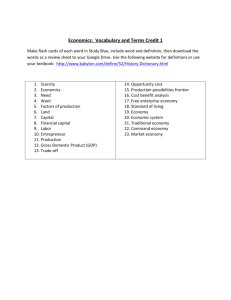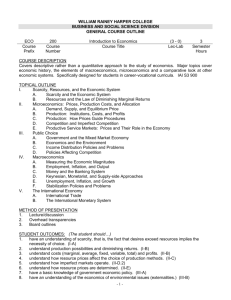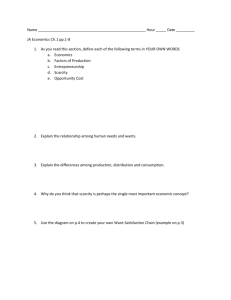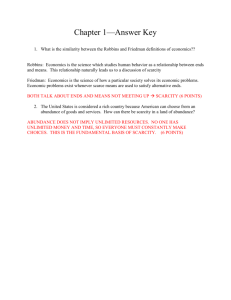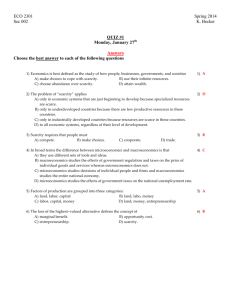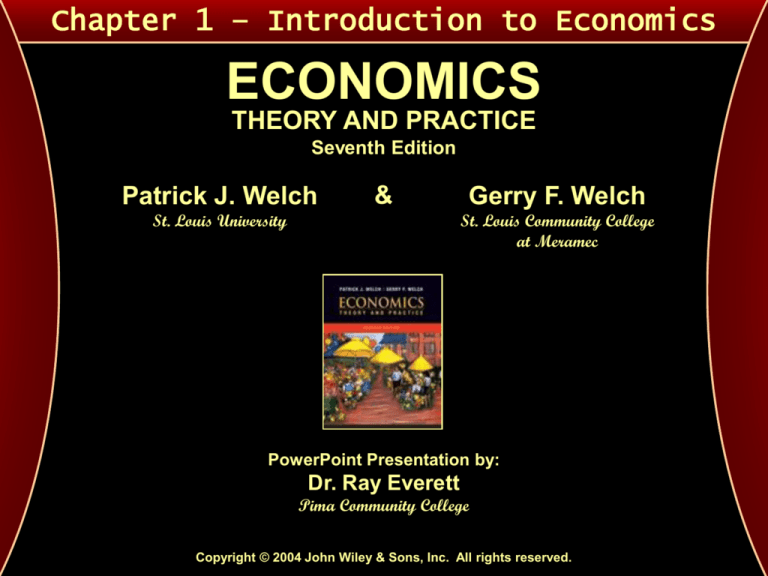
Chapter 1 – Introduction to Economics
ECONOMICS
THEORY AND PRACTICE
Seventh Edition
Patrick J. Welch
&
St. Louis University
Gerry F. Welch
St. Louis Community College
at Meramec
PowerPoint Presentation by:
Dr. Ray Everett
Pima Community College
Copyright © 2004 John Wiley & Sons, Inc. All rights reserved.
Introduction to Economics
Contents
Economics & Scarcity
Efficiency & Equity
Factors of Production
Economic Theory & Policy
Tools of the Economist
Scarcity, Model Building, & Graphs
Macroeconomics & Microeconomics
Graphing (Chapter 1 Appendix)
Introduction to Economics
Chapter Objectives
• To define economics and introduce the scarcity problem, which
underlies economics.
• To understand the relationship between scarcity and choice.
• To define opportunity cost.
• To explore how efficiency and equity are related to the problem of
scarcity.
• To identify four factors of production and the income return to each
type of factor.
• To differentiate between economic theory and economy policy.
• To introduce the tools economists use to express theories and
policies.
• To use the production possibilities model to illustrate and explain the
basic problem of scarcity.
• To differentiate between macroeconomics and microeconomics.
• To explain how to construct a graph and interpret the illustrated
relationship.
Economics & Scarcity
1-1
• Economics
Study of how scarce, or limited,
resources are used to satisfy
people’s unlimited material wants
and needs.
• Scarcity
Inability to provide enough goods
and/or services to satisfy the wants
and needs of all people.
• Opportunity Cost
Cost of a purchase or a decision
measured in terms of a foregone
alternative.
FIGURE 1-1
Scarcity, Choice, and
Influences on Decision
Makers
Efficiency & Equity
• Efficiency
Producing the largest attainable output of a desired
quality from a given set of resources; occurs when goods
and services are produced at the lowest possible cost.
• If all goods and services were produced efficiently, society
would experience the greatest possible lessening of the
scarcity problem.
• Equity
Just and equitable distribution of goods and services.
• The concept of what constitutes an equitable distribution of
goods and services is controversial because it is based on
people’s value judgments.
1-2
Factors of Production
• Factors of Production
Resources used to produce goods and services, and
which are classified into one of four categories:
• Labor – includes all effort, both physical and mental;
receives wages
• Capital – includes warehouses, machinery, and equipment;
receives interest
• Land – includes all nature-originating production inputs;
receives rent
• Entrepreneurship – performance of a number of critical
tasks that are carried out in all productive processes;
receives profit
FIGURE 1-2
Relationship between Resources and Wants and Needs
1-3
Economic Theory & Policy
• Economic Theory
Formal explanation of the relationship between economic
variables; provides a reason why something happens,
offers a cause-and-effect interpretation for a set of
events, or shows the effect on one variable when another
changes.
• Theories are often explored within the framework of a
model, which is composed of several elements:
• Economic Policy
Action taken to change
or remedy an economic
condition, which is often
a result of a decision
made by a policymaker.
FIGURE 1-3
Economic Theory and Models
1-4
Tools of the Economist
• To express economic theories and policies, economists
often use one of three methods:
Verbal presentation – descriptive statement used to state
the relationship between economic variables
• The quantity of coffee demanded will fall as its price
increases.
Graph – picture used to illustrate the relationship
between economic variables
•
Mathematical equation – written mathematical equation
used to prove the relationship between economic
variables
•
QC 600 100PC
1-5
Scarcity, Model Building, & Graphs
• In the following model all of a hypothetical economy’s
resources will be diverted to the production of only two
goods: VCRs and SUVs.
• Production Possibilities Table
Lists the possible levels of production in an economy.
1-6a
Scarcity, Model Building, & Graphs
• Production Possibilities Curve
Formed when data points from the production
possibilities table are plotted on a graph and connected.
• With the introduction of unemployment into the model,
the economy is unable to produce at its full potential.
• With the introduction of economic growth into the
model, the economy is able to produce above its
previous full potential.
1-6b
Microeconomics & Macroeconomics
• Macroeconomics
Focuses on the operation of the economy as a whole and
the interactions of the household, business, government,
and foreign sectors in the economy.
• It includes such topics as inflation, unemployment, taxes
and government spending, and money.
• Microeconomics
Focuses on the behavior of individual businesses and
households and on specific product and resource
markets.
• It includes such topics as consumer behavior, cost-benefit
analysis, the determination of business profits, and the
determination of prices in specific markets.
1-7
Graphing (Appendix Slide 1)
• Graph
Picture of a relationship between two variables; variables
are given on the vertical and horizontal axes of the graph,
and the line in the graph provides a visual image of how
those variables are related.
• Graphs can be constructed in three steps:
• Step 1
Identify the variables to be placed on the axes.
• Money data is often placed on the vertical axis.
1-8
Graphing (Appendix Slide 2)
• Step 2
Assign numbers along the axes.
• Always use zero at the origin.
• Work up the number scale as you go out on each axis.
• Use equal spaces for equal amounts along the axes.
• Step 3
Plot the data points and link the data points with a line.
1-9
Graphing (Appendix Slide 3)
• Direct Relationship
Both variables move in the same direction; that is, as one
gets larger or smaller, so does the other.
• Indirect Relationship
Both variables move in opposite directions; that is, as
one becomes larger, the other becomes smaller, and vice
versa.
1-10
Graphing (Appendix Slide 4)
• What type of relationship (direct or inverse) is illustrated
in each of these graphs?
• Electric Usage from Air Conditioning
Direct
• Hours of Study
Direct
• Price per Bottle of Wine
Inverse
1-11
Graphing (Appendix Slide 5)
1-12
• The appearance of data in a graph can be affected by
how the axes of the graph are numbered.
In the graph on the left, the interval of five pounds results
in a more jagged line and better represents the yearly
fluctuations.
In the graph on the right, the interval of twenty-five
pounds results in a smoother line.
FIGURE 1-7 Economic Growth in a Production Possibilities Model
Chapter 1 - Introduction to Economics
This is the end of Chapter 1.
To return to the contents menu of this
chapter, click on the menu graphic to the
right of this text.
To begin Chapter 2, click on the next
chapter icon to the right of this text.
Menu
Next
Chapter
ECONOMICS
THEORY AND PRACTICE
Seventh Edition
Copyright © 2004 John Wiley & Sons, Inc. All rights reserved. Reproduction or translation of this work
beyond that permitted in Section 117 of the 1976 United States Copyright Act without the expressed
written permission of the copyright owner is unlawful. Request for further information should be
addressed to the Permissions Department, John Wiley & Sons, Inc. The purchaser may make back-up
copies for his/her own use only and not for distribution or resale. The Publisher assumes no
responsibility for errors, omissions, or damages, caused by the use of these programs or from the use
of the information contained herein.

